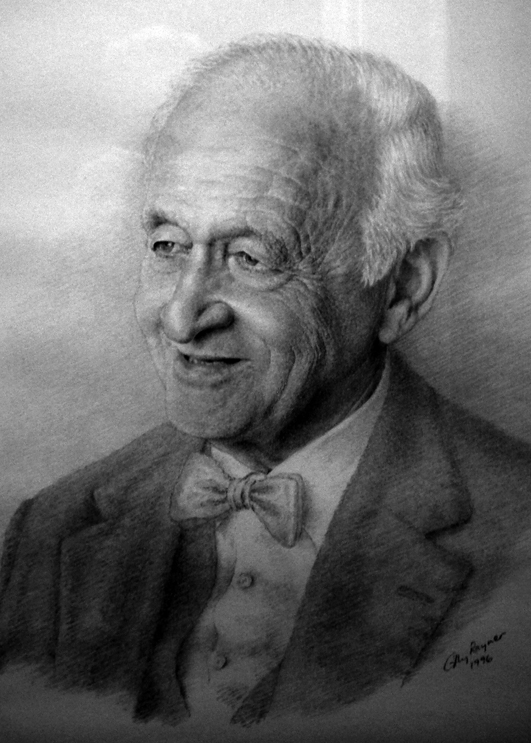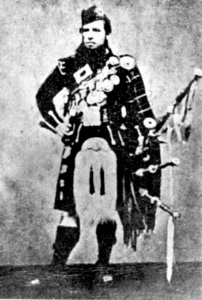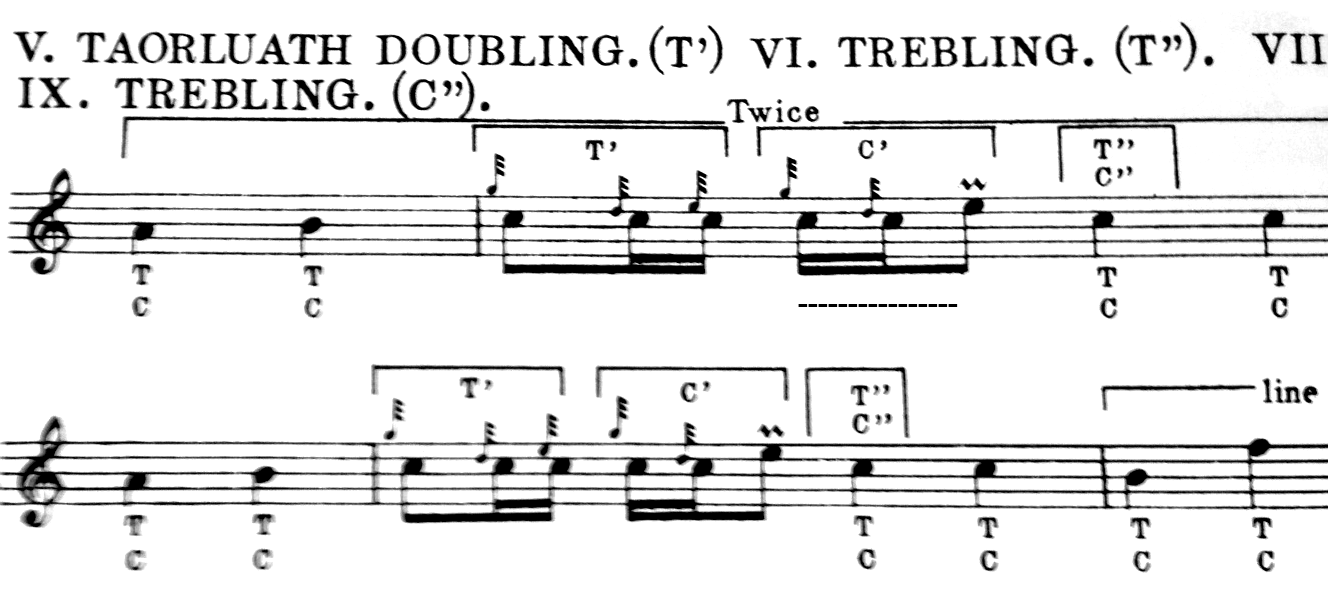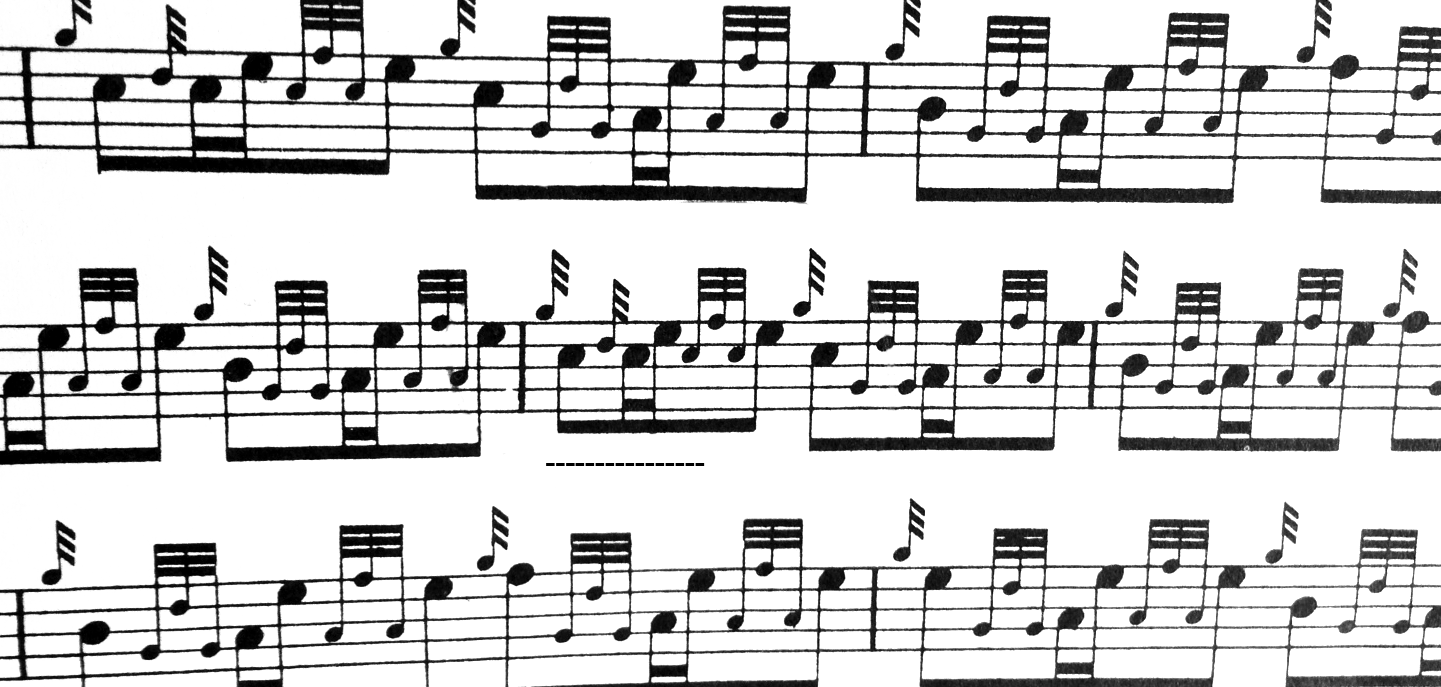Cameron v Macpherson and
Correspondence Thereon
By Norman Matheson
 Controversy, characterised by opposing and irreconcilable views on specific issues, has been an inevitable consequence of dogmatism in piobaireachd interpretation. Although the historical reality of two different strands of interpretation, ‘schools’ as it were, may be open to question, controversy has often stemmed from what was allegedly played and taught on the one hand by Malcolm Macpherson (Calum Piobair) and on the other by the Camerons. The notion of fundamental differences was fuelled by Angus Macpherson, the youngest of Malcolm’s three sons. Angus used to protest against any Cameron influence in his father’s playing and was therefore an unwitting protagonist of the concept of two ‘schools’ although in his eyes the Cameron ‘school’ would never have merited equal status. The basis of Angus’s adamant, though curious, opinion has never been clear and it does not stand up to scrutiny.
Controversy, characterised by opposing and irreconcilable views on specific issues, has been an inevitable consequence of dogmatism in piobaireachd interpretation. Although the historical reality of two different strands of interpretation, ‘schools’ as it were, may be open to question, controversy has often stemmed from what was allegedly played and taught on the one hand by Malcolm Macpherson (Calum Piobair) and on the other by the Camerons. The notion of fundamental differences was fuelled by Angus Macpherson, the youngest of Malcolm’s three sons. Angus used to protest against any Cameron influence in his father’s playing and was therefore an unwitting protagonist of the concept of two ‘schools’ although in his eyes the Cameron ‘school’ would never have merited equal status. The basis of Angus’s adamant, though curious, opinion has never been clear and it does not stand up to scrutiny.

James Campbell writes (17.05.2000): ‘I do not know why Angus was so vehement in his denial of any Cameron influence on his father. Angus was only 20 when his father died and it occurs to me that his anti-Cameron attitude may have stemmed from talks with his elder brothers who may have been caught up in the north-south rivalry which flourished in those days. The Glasgow pipers probably gave themselves airs over the presence in their midst of MacDougall Gillies and may have built him up as a sort of icon of ‘Cameron’ virtue.’
James’s speculation on Angus’s bias is much less significant than the factual content of two letters copied from his files, one written by his father and the other by John MacDonald [Inverness]. The following are brief excerpts: Kilberry to Rothiemurchus (Sheriff J.P.Grant) 23.09.1946: ‘We didn’t stay too long with John MacDonald as he seemed rather tired, and didn’t hear anything particularly fresh. He repeated what he had emphasised before, that anything that old Calum Macpherson got, he got from Sandy Cameron the elder.’
John MacDonald to Kilberry (July 1938): ‘The most consistent player of all was Calum Macpherson, who in my opinion played some tunes much more pleasing than either of the Camerons. He told me he got most of his learning from Sandy Cameron, Greenock.’

James writes (01.05.2000):
1. ‘A. Cameron kept a hotel in Greenock at the time when Malcolm Macpherson was working there as a young man. They were both members of the same pipe band. I find it unlikely that Macpherson, a young and presumably inquisitive student of piobaireachd, would not have come under the influence of Cameron, who is described in W.L. Manson’s ‘The Highland Bagpiper’ (page 284) as having been ‘looked on as the MacCrimmon of his day’.
- The recorded playing of William MacLean, a pupil of Malcolm Macpherson, contains many of what some today would label ‘Cameron’ as opposed to ‘Macpherson’ touches (e.g. pre-cadence pause in crunluath singlings, fullness of 2nd note in two-note cadences and of 3rd note in three-note cadences).
- In the Notices of Pipers, the notice on Malcolm Macpherson (reprinted in the Piping Times Vol.24, No.12, p30) includes this: ‘Taught by his father and by Sandy Cameron when in Greenock as a young man, as a ship’s carpenter.’
In conclusion, there appears to be no doubt that Malcolm Macpherson received tuition from Sandy Cameron (the elder). On that basis, differences between the two camps, headed usually by John MacDonald on the Macpherson side and Sandy (Alick) Cameron (the younger) on the other, were all the more surprising. The history of such disputes, together with James Campbell’s insights makes interesting reading. In addition, although disagreements on interpretation have in some cases died down as more flexible views have evolved, there are some that linger on.
The Pre-cadence Pause: This minor bone of contention, mentioned in relation to William MacLean’s playing, refers to the duration of the final E of the crunluath movement when it immediately precedes a GED cadence. Bob Nicol insisted that in all crunluath movements the final E should be short with brisk transfer to the next melody note, whether or not a cadence intervenes. A pre-cadence pause, in which the crunluath E is elongated before a cadence was anathema to Nicol. John MacDonald’s opinion is recorded in Sheriff Grant’s notes (24.03.1949): ‘I asked J.M.’s ruling on pauses (if any) in taorluath and crunluath variations. He said emphatically no pauses either on A of taorluath or E of crunluath; he said it was a modern practice, popularised by MacDougall Gillies.’ It is amusing to look back to the bad old days when rancour between North and South could result in such a minor preference being frowned upon as a disagreeable Glasgow trait.
James had this to say (01.05.2000): ‘I see the Balmoral view that this pause is wrong as unusually dogmatic in the light of the ‘Cameron’ authority to the contrary. Whenever I have occasion to offer advice on this one, I say that there is good authority both for the pause and for no pause. On the subject of the taorluath pause I say that it sounds horrible and advise against it. And if the enquirer takes the point that if a crunluath pause is permissible it is illogical to deny the taorluath pause, I would say, ‘If that’s how you feel, for goodness sake adopt the no-pause-on-either option’. Anything is preferable to a taorluath pause!’
Later he reflected (17.05.2000): ‘I agree it is often overdone and that is another reason why, if there is to be a rule on the subject, a ‘no pause at all’ rule is to be preferred.’
The Cruluath Fosgailte a Mach: The playing of an open crunluath fosgailte variation after a closed variation as a crunluath fosgailte ‘a mach’, is another instance of dispute in which John MacDonald’s teaching was at variance with Sandy Cameron’s advice to Kilberry. James Campbell commented (21.01.2002): ‘I dug up a letter which my father wrote in November 1945 to Frank Richardson in which, on the subject under investigation, this was said: ‘Open Crunluath Fosgailte. Nor can I say more about this save that Sandy Cameron told me to play it. Personally I do not care for it, but this fact weighs nothing with me, whose sole object is to play as he was taught and not as he fancies. Ross [Willie] may or may not be correct when he says that Colin Cameron ‘checked’ him at Braemar for not playing an open cr. fosgailte. I don’t know what John MacDonald’s recollection is of what Colin and Sandy Cameron said to him. I did not argue with or question Sandy but just accepted what he said.’
James continues: ‘The problem stems from the rigidity of belief in both my father and John MacDonald that what Sandy Cameron did or said at a particular moment in time represented his immutable practice. It never occurred to either of them that on matters of peripheral importance Cameron’s inclinations may have varied. I have no difficulty in accepting that Cameron may have said X at one time and Y at another.’
In a recent article on this topic evidence was given that adding an open crunluath fosgailte as an ‘a mach’ variation is contrary to tradition. Nonetheless, Sandy Cameron clearly had a liking for it, at least at one time, and advised Kilberry to play it in certain tunes. Despite conviction on its historical invalidity, it seems inappropriate in a competitive setting, to lay down rigid rules against a competitor’s personal preference.
Breabach Variations: A surprising conflict of opinion surfaced in 1938 in relation to one of the set tunes, MacDonald of Kinlochmoidart’s Lament No.1, which includes a taorluath breabach variation. The playing of the taorluath breabach ‘down’ (the last note of the taorluath held and the next note cut) by Archie MacNab, one of the prize winners, provoked an aggrieved letter from Willie Ross to Kilberry asserting that MacDougall Gillies, Sandy Cameron and Malcolm Macpherson all played it ‘up’ (the last note in the group longer than the preceding low A).
James Campbell writes (10.07.2003): ‘In my lecture on ‘The Set Tunes for 1938’ at the 1986 P.S. Conference, I referred to letters passing between John MacDonald and my father on the subject of the timing of the taorluath breabach. How did the Camerons time it, ‘up’ or ‘down’? My father swore that Sandy Cameron played it ‘up’ and John MacDonald swore that he [Cameron] played it ‘down’. In one of the letters J. M. said that he had never heard either Colin or Sandy playing a taorluath breabach other than ‘down’. It did not occur to either that Sandy Cameron may have varied his timing in different situations.’
James’s definitive commentary on breabach variations and the related controversy may be read in the proceedings of the 1986 conference. In addition, in 2004, the topic was reconsidered in detail in the Piping Times (Vol.56, No.8, p11). Fortunately, this irreconcilable dispute is no longer significant since it has been overtaken by good sense. Nowadays a taorluath breabach variation may be played in either way according to taste in whatever tune it appears. In general it appears to be more commonly played ‘down’ but with many exceptions.
However, in contrast to that welcome flexibility, the crunluath breabach has stood still. Today it is almost always played in a standard way in which the final two notes after the E of the crunluath movement (both usually even quavers in P.S. settings) are given more or less equal weight. John MacDonald was evidently adamant on that point and, although, according to Kilberry, Sandy Cameron and MacDougall Gillies gave the first of the two notes (low A) slight emphasis, there was no fundamental difference between the two camps and there were no exceptions to the standard rule.
I have listened to Angus Macpherson lamenting the loss of a tradition whereby the emphasis on the two notes was variable according to the foregoing melody. He would cite Isabel MacKay as an example in which, in keeping with the melodic theme, the crunluath breabach was played ‘up’, i.e. with emphasis on the second note. That is the way in which it is written in Binneas is Boreraig. In his 1986 P.S. lecture, James Campbell recorded that in some tunes, specifically in The Lament for Captain MacDougall, John MacDonald, before the First World War, played the movement ‘up’, as did Willie Ross and that in his later days MacDougall Gillies sometimes taught the movement ‘up’.
In response to a letter on this topic, James wrote (21.02.2000): ‘Crunluath breabach. I am with Angus Macpherson on this one. My father was firm in his insistence on one way of playing the movement in all tunes. Except for the slight emphasis on low A (clumsily portrayed in the text but clearly explained in the second paragraph on page 19 of the Kilberry Book introduction) he was as one with John MacDonald on this one. I used to try to convert him to the elegance of the more flexible view, but no – Sandy Cameron had it thus and that was it as far as he was concerned. You mention that Binneas is Boreraig has Isabel MacKay with an ‘up’ crunluath following an ‘up’ taorluath and the same treatment is afforded to MacSwan of Roaig. But consistency is lost with a ‘down’ crunluath preceded by an ‘up’ taorluath in the Little Supper, in MacFarlanes’ Gathering, in Tulloch Ard and in I am Proud.’
In tunes such as Isabel MacKay and several others in which the taorluath breabach may preferably be played ‘up’ in keeping with the foregoing melody, to follow on with the crunluath breabach in the standard way abandons the theme and sounds musically discordant. There is much to be said for maintaining melodic consistency throughout. Both Angus Macpherson and James Campbell would have agreed with that. Hopefully, the liberal attitude to the playing of taorluath breabach variations may yet extend to include crunluath variations.
The Strange Crunluath: Much has been written on the ‘strange’ crunluath, most often heard in the Battle of the Pass of Crieff and the MacKays’ Banner, though it also occurs in several other less common tunes. It certainly sounds ‘strange’ when played as written in all P.S. versions under Archibald Campbell’s editorship, and in his Kilberry Book. In these publications, although the length of the second note is variable, the consistent features are that first note is short and the subsequent dre is played off low A.

Older sources, although there is some variability, do not show the movement in that way. Both Angus MacKay and Donald MacDonald always show the first note as a melody note and, almost always, the dre open.

In essence the conflict is between the traditional portrayal (long melody note followed by an open movement) and the P.S./Kilberry portrayal. It should be stressed that Kilberry’s depiction was based on Cameron teaching. Relevant information in greater detail is given in the above references.
Angus Macpherson insisted that in the past the movement had always been played as written by Angus MacKay. According to Brown, John MacDonald shared that view but advised him to play it in the P.S./Kilberry way, otherwise he would never get a prize! Brown mentions that advice in relation to the Battle of the Pass of Crieff in Masters of Piobaireachd Vol.1. Nicol also preferred the ‘MacKay’ version, which he taught in the MacKays’ Banner (MoP, Vol.8). James Campbell, while stressing that he would not see either choice as ‘right’ or ‘wrong’, has expressed a personal preference for the ‘MacKay’ style. He writes (10.07.2003): ‘It remains to be seen whether anyone will have the courage to deviate from what is written in the Pass of Crieff in the Kilberry and P.S. books. Personally I doubt if there will be any with the enterprise to do so, as I suspect that people will be more likely to ‘play safe’, as Brown was advised to do by John MacDonald.’
Nevertheless, although it may be conceded as a matter of individual preference, the ‘MacKay’ version, which corresponds to preceding taorluath variations and maintains melodic flow in crunluath variations, has much to commend it in a musical sense.
• Read more on James Campbell from the lecture given by Jonathan Gillespie.



















